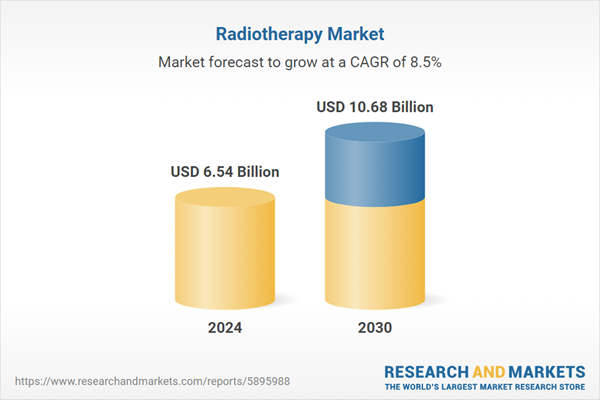Speak directly to the analyst to clarify any post sales queries you may have.
10% Free customizationThis report comes with 10% free customization, enabling you to add data that meets your specific business needs.
Key Market Drivers
Technological Advancements
Ongoing technological innovations have significantly fueled the growth of the Global Radiotherapy Market. The emergence of advanced techniques like Intensity-Modulated Radiation Therapy (IMRT), Stereotactic Body Radiation Therapy (SBRT), and Proton Therapy has revolutionized cancer care by enabling highly accurate targeting of tumors while preserving surrounding healthy tissue.This precision leads to improved outcomes and fewer adverse effects, making radiotherapy a preferred choice. Artificial Intelligence (AI) and Machine Learning (ML) are increasingly integrated into treatment planning, enhancing dose optimization and patient response prediction. Image-Guided Radiotherapy (IGRT) further ensures real-time monitoring during treatment, improving targeting accuracy. Additionally, the development of Radiosurgery and Stereotactic Radiosurgery (SRS) allows for high-dose, single-session treatments for small tumors, offering patients convenience and reduced treatment durations.
Key Market Challenges
Cost and Accessibility Barriers
One of the major barriers in the radiotherapy market is the high cost of implementation. Advanced radiotherapy systems, such as linear accelerators and proton therapy units, demand substantial capital investment, which can be a major hurdle for healthcare providers, especially in under-resourced regions. Beyond the purchase, ongoing maintenance, staff training, and operational expenses place additional financial pressure on facilities. Disparities in access are also a concern, with rural and low-income areas often lacking sufficient infrastructure for radiotherapy services. These challenges contribute to unequal access to advanced cancer care, limiting the market's reach and slowing the pace of widespread adoption despite growing demand.Key Market Trends
Advanced Radiation Delivery Techniques
The evolution of advanced radiation delivery methods is reshaping the radiotherapy landscape. Techniques such as IMRT allow for modulation of radiation intensity to different areas of the tumor, minimizing impact on nearby healthy tissues and improving treatment precision. Proton therapy offers an even more targeted approach, as protons release energy directly at the tumor site, reducing collateral damage. Additionally, hypofractionation - delivering higher doses over fewer sessions - is gaining popularity for its convenience and efficiency. Stereotactic Radiosurgery (SRS), a form of hypofractionation, is increasingly used for treating small brain and body tumors. These innovations align with the growing demand for personalized treatment strategies that prioritize both efficacy and patient quality of life.Key Market Players
- Canon Medical Systems Corporation
- GE Healthcare
- Elekta
- ViewRay Technologies, Inc.
- Mevion Medical Systems
- Eckert & Ziegler (BEBIG Medical)
- Siemens Healthineers AG
- Accuray Incorporated
- Isoray Inc.
- Hitachi, Ltd.
- ALCEN (PMB)
Report Scope:
In this report, the Global Radiotherapy Market has been segmented into the following categories, in addition to the industry trends which have also been detailed below:Radiotherapy Market, By Type:
- External Beam Radiation Therapy
- Internal Radiation Therapy
- Systemic Radiation Therapy
Radiotherapy Market, By Application:
- Skin & Lip Cancer
- Breast Cancer
- Prostate Cancer
- Cervical Cancer
- Lung Cancer
- Others
Radiotherapy Market, By End-User:
- Hospitals
- Research Institutes
- Ambulatory and Radiotherapy Centers
Radiotherapy Market, By Region:
- North America
- United States
- Canada
- Mexico
- Europe
- France
- United Kingdom
- Italy
- Germany
- Spain
- Asia-Pacific
- China
- India
- Japan
- Australia
- South Korea
- South America
- Brazil
- Argentina
- Colombia
- Middle East & Africa
- South Africa
- Saudi Arabia
- UAE
Competitive Landscape
Company Profiles: Detailed analysis of the major companies present in the Global Radiotherapy Market.Available Customizations:
With the given market data, the publisher offers customizations according to a company's specific needs. The following customization options are available for the report.Company Information
- Detailed analysis and profiling of additional market players (up to five).
This product will be delivered within 1-3 business days.
Table of Contents
Companies Mentioned
- Canon Medical Systems Corporation
- GE Healthcare
- Elekta
- ViewRay Technologies, Inc.
- Mevion Medical Systems
- Eckert & Ziegler (BEBIG Medical)
- Siemens Healthineers AG
- Accuray Incorporated
- Isoray Inc.
- Hitachi, Ltd.
- ALCEN (PMB)
Table Information
| Report Attribute | Details |
|---|---|
| No. of Pages | 183 |
| Published | May 2025 |
| Forecast Period | 2024 - 2030 |
| Estimated Market Value ( USD | $ 6.54 Billion |
| Forecasted Market Value ( USD | $ 10.68 Billion |
| Compound Annual Growth Rate | 8.5% |
| Regions Covered | Global |
| No. of Companies Mentioned | 11 |









